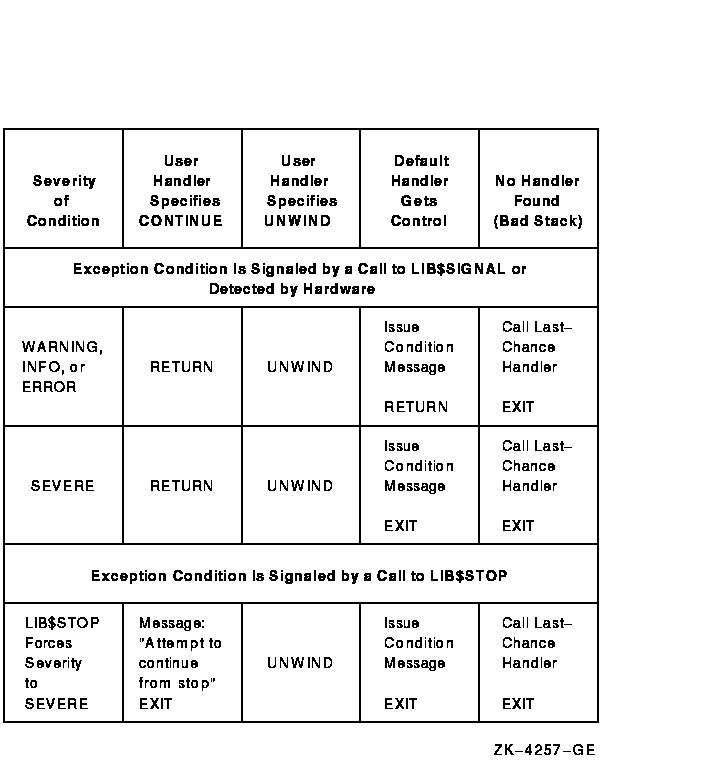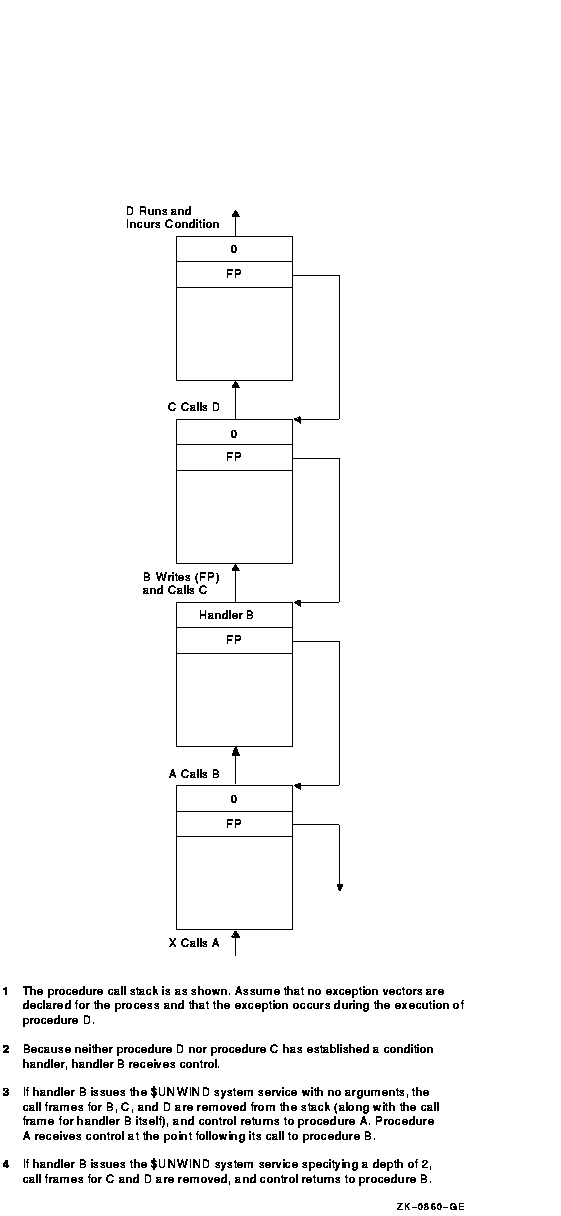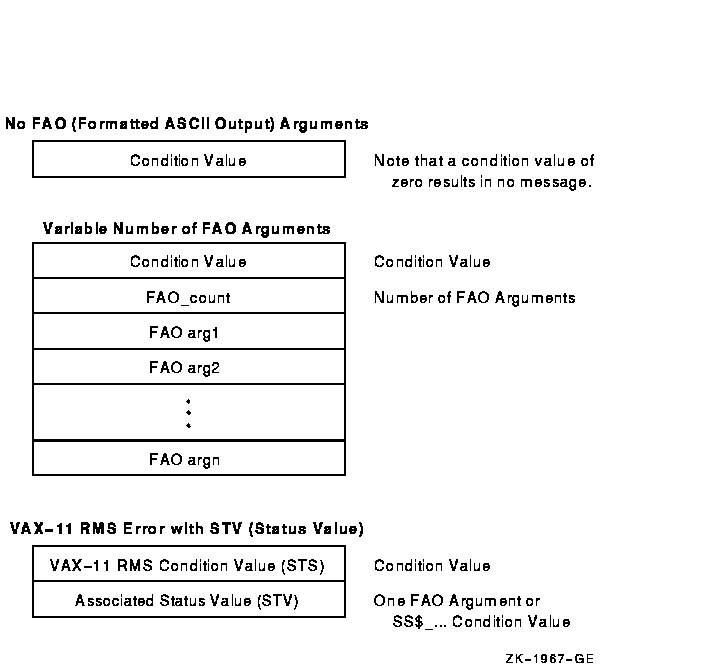 |
HP OpenVMS systems documentation |
| Previous | Contents | Index |
On VAX systems, when a routine is activated, the first longword in its stack frame is set to 0. This longword is reserved to contain an address pointing to another routine called the condition handler. If an exception condition is signaled during the execution of the routine, the OpenVMS Condition Handling Facility uses the address in the first longword of the frame to call the associated condition handler.
Each procedure, other than a null frame procedure, can have a condition handler potentially associated with it, which is identified by the HANDLER_VALID, STACK_HANDLER, or REG_HANDLER fields of the associated procedure descriptor in an Alpha system, or the handler field in the associated unwind information block on an I64 system. You establish a handler by including the procedure value of the handler procedure in that field. See the HP OpenVMS Calling Standard for additional information.
The arguments passed to the condition-handling routine are the signal and mechanism argument vectors, described in Section 9.8.2, Section 9.8.3, and Section 9.8.4.
Various types of condition handlers can be called for a given routine:
The operating system establishes the following default condition handlers each time a new image is started. The default handlers are shown in the order they are encountered when the operating system processes a signal. These three handlers are the only handlers that output error messages.
| Severity | Error Type | Action |
|---|---|---|
| 1 | Success | Continue |
| 3 | Information | Continue |
| 0 | Warning | Continue |
| 2 | Error | Continue |
| 4 | Severe | Exit |
Displays the message associated with the condition code and then continues program execution or, if the error is severe, terminates execution. The catchall handler is not invoked if the traceback handler is enabled.
In the following example, if the condition code INCOME_LINELOST is signaled at line 496 of GET_STATS, regardless of which default handler is in effect, the following message is displayed:
%INCOME-W-LINELOST, Statistics on last line lost due to CTRL/Z |
If the traceback handler is in effect, the following text is also displayed:
%TRACE-W-TRACEBACK, symbolic stack dump follows
module name routine name line rel PC abs PC
GET_STATS GET_STATS 497 00000306 00008DA2
INCOME INCOME 148 0000015A 0000875A
0000A5BC 0000A5BC
00009BDB 00009BDB
0000A599 0000A599
|
Because INCOME_LINELOST is a warning, the line number of the next
statement to be executed (497), rather than the line number of the
statement that signaled the condition code, is displayed. Line 148 of
the program unit INCOME invoked GET_STATS.
9.9.2 Interaction Between Default and User-Supplied Handlers
Several results are possible after a routine signals, depending on a number of factors, such as the severity of the error, the method of generating the signal, and the action of the condition handlers you have defined and the default handlers. Given the severity of the condition and the method of signaling, Figure 9-13 lists all combinations of interaction between user condition handlers and default condition handlers.
Figure 9-13 Interaction Between Handlers and Default Handlers

9.10 Types of Actions Performed by Condition Handlers
When a condition handler returns control to the OpenVMS Condition
Handling facility (CHF), the facility takes one of the following types
of actions, depending on the value returned by the condition handler:
One type of action a condition handler can take is to unwind the procedure call stack. The unwind operation is complex and should be used only when control must be restored to an earlier procedure in the calling sequence. Moreover, use of the SYS$UNWIND system service requires the calling condition handler to be aware of the calling sequence and of the exact point to which control is to return.
SYS$UNWIND accepts two optional arguments:
If no argument is supplied to SYS$UNWIND, the unwind is performed to the caller of the procedure that established the condition handler that is issuing the SYS$UNWIND service. Control is returned to the address specified in the return PC for that procedure. Note that this is the default and the normal case for unwinding.
Another common case of unwinding is to unwind to the procedure that declared the handler. On VAX systems, this is done by using the depth value from the exception mechanism array (CHF$L_MCH_DEPTH) as the depth argument to SYS$UNWIND. On Alpha and I64 systems, this is done by using the depth value from the exception mechanism array (CHF$IS_MCH_DEPTH) as the depth argument to SYS$UNWIND.
Therefore, it follows that the default unwind (no depth specified) is equivalent to specifying CHF$L_MCH_DEPTH plus 1 on VAX systems. On Alpha and I64 systems, the default unwind (no depth specified) is equivalent to specifying CHF$IS_MCH_DEPTH plus 1. In certain instances of nested exceptions, however, this is not the case. HP recommends that you omit the depth argument when unwinding to the caller of the routine that established the condition handler.
Figure 9-14 illustrates an unwind situation and describes some of the possible results.
The unwind operation consists of two parts:
For this reason, the stack is in an intermediate state directly after calling SYS$UNWIND. Handlers should, in general, return immediately after calling SYS$UNWIND.
During the actual unwinding of the call stack, the unwind routine examines each frame in the call stack to see whether a condition handler has been declared. If a handler has been declared, the unwind routine calls the handler with the status value SS$_UNWIND (indicating that the call stack is being unwound) in the condition name argument of the signal array. When a condition handler is called with this status value, it can perform any procedure-specific cleanup operations required. For example, the handler should deallocate any processwide resources that have been allocated. Then, the handler returns control to the OpenVMS Condition Handling facility. After the handler returns, the call frame is removed from the stack.
When a condition handler is called during the unwinding operation, the condition handler must not generate a new signal. A new signal would result in unpredictable behavior.
Thus, in Figure 9-14, handler B can be called a second time, during the unwind operation. Note that handler B does not have to be able to interpret the SS$_UNWIND status value specifically; the return instruction merely returns control to the unwind procedure, which does not check any status values.
Handlers established by the primary, secondary, or last-chance vector are not called, because they are not removed during an unwind operation.
While it is unwinding the stack, the OpenVMS Condition Handling facility ignores any function value returned by a condition handler. For this reason, a handler cannot both resignal and unwind. Thus, the only way for a handler to both issue a message and perform an unwind is to call LIB$SIGNAL and then call $UNWIND. If your program calls $UNWIND before calling LIB$SIGNAL, the result is unpredictable.
When the OpenVMS Condition Handling facility calls the condition handler that was established for each frame during unwind, the call is of the standard form, described in Section 9.2. The arguments passed to the condition handler (the signal and mechanism argument vectors) are shown in Section 9.8.2, Section 9.8.3, and Section 9.8.4.
On VAX systems, if the handler is to specify the function value of the last function to be unwound, it should modify the saved copies of R0 and R1 (CHF$L_MCH_SAVR0 and CHF$L_MCH_SAVR1) in the mechanism argument vector.
On Alpha and I64 systems, the handler should modify the saved copies of R0 and R1 (R8, R9 for I64) (CHF$IH_MCH_SAVRnn).
R0 and R1 (R8, R9 for I64) are restored from the mechanism argument vector at the end of the unwind.
Figure 9-14 Unwinding the Call Stack

9.10.2 GOTO Unwind Operations (Alpha and I64 Only)
On Alpha systems, a current procedure invocation is one in whose
context the thread of execution is currently executing. At any instant,
a thread of execution has exactly one current procedure. If code in the
current procedure calls another procedure, then the called procedure
becomes the current procedure. As each stack frame or register frame
procedure is called, its invocation context is recorded in a procedure
frame. The invocation context is mainly a snapshot of process registers
at procedure invocation. It is used during return from the called
procedure to restore the calling procedure's state. The chain of all
procedure frames starting with the current procedure and going all the
way back to the first procedure invocation for the thread is called the
call chain. While a procedure is part of the call
chain, it is called an active procedure.
When a current procedure returns to its calling procedure, the most recent procedure frame is removed from the call chain and used to restore the now current procedure's state. As each current procedure returns to its calling procedure, its associated procedure frame is removed from the call chain. This is the normal unwind process of a call chain.
You can bypass the normal return path by forcibly unwinding the call chain. The Unwind Call Chain (SYS$UNWIND) system service allows a condition handler to transfer control from a series of nested procedure invocations to a previous point of execution, bypassing the normal return path. The Goto Unwind (SYS$GOTO_UNWIND) system service allows any procedure to achieve the same effect. (On I64 systems SYS$GOTO_UNWIND does not exist, use SYS$GOTO_UNWIND_64.) SYS$GOTO_UNWIND (SYS$GOTO_UNWIND_64) restores saved register context for each nested procedure invocation, calling the condition handler, if any, for each procedure frame that it unwinds. Restoring saved register context from each procedure frame from the most recent one to the target procedure frame ensures that the register context is correct when the target procedure gains control. Also, each condition handler called during unwind can release any resources acquired by its establishing procedure.
For information about the GOTO unwind operations and how to use the
SYS$GOTO_UNWIND (SYS$GOTO_UNWIND_64) system service, see the
HP OpenVMS Calling Standard and the HP OpenVMS System Services Reference Manual.
9.11 Displaying Messages
The standard format for a message is as follows:
|
%facility-l-ident, message-text |
| facility | Abbreviated name of the software component that issued the message |
| l | Indicator showing the severity level of the exception condition that caused the message |
| ident | Symbol of up to nine characters representing the message |
| message-text | Brief definition of the cause of the message |
The message can also include up to 255 formatted ASCII output (FAO) arguments. These arguments can be used to display variable information about the condition that caused the message. In the following examples, the file specification is an FAO argument:
%TYPE-W-OPENIN, error opening _DB0:[FOSTER]AUTHOR.DAT; as input |
For information about specifying FAO parameters, see Section 9.11.4.3.
Signaling provides a consistent and unified method for displaying messages. This section describes how the OpenVMS Condition Handling facility translates the original signal into intelligible messages.
Signaling is used to signal exception conditions generated by HP software. When software detects an exception condition, it signals the exception condition to the user by calling LIB$SIGNAL or LIB$STOP. The signaling routine passes a signal argument list to these run-time library routines. This signal argument list is made up of the condition value and a set of optional arguments that provide information to condition handlers.
You can use the signaling mechanism to signal messages that are specific to your application. Further, you can chain your own message to a system message. For more information, see Section 9.11.3.
LIB$SIGNAL and LIB$STOP copy the signal argument list and use it to create the signal argument vector. The signal argument vector serves as part of the input to the user-established handlers and the system default handlers.
If all intervening handlers have resignaled, the system default handlers take control. The system-supplied default handlers are the only handlers that should actually issue messages, whether the exception conditions are signaled by HP software or your own programs. That is, a routine should signal exception conditions rather than issue its own messages. In this way, other applications can call the routine and override its signal in order to change the messages. Further, this technique decides formatting details, and it also keeps wording centralized and consistent.
The system default handlers pass the signal argument vector to the Put Message (SYS$PUTMSG) system service. SYS$PUTMSG formats and displays the information in the signal argument vector.
SYS$PUTMSG performs the following steps:
You can use the signal array that the operating system passes to the condition handler as the first argument of the SYS$PUTMSG system service. The signal array contains the condition code, the number of required FAO arguments for each condition code, and the FAO arguments (see Figure 9-15). The HP OpenVMS System Services Reference Manual contains complete specifications for SYS$PUTMSG.
See Section 9.11.2 for information about how to create and suppress messages on a running log using SYS$PUTMSG.
The last two array elements, the PC and PSL, are not FAO arguments and should be deleted before the array is passed to SYS$PUTMSG. Because the first element of the signal array contains the number of longwords in the array, you can effectively delete the last two elements of the array by subtracting 2 from the value in the first element. Before exiting from the condition handler, you should restore the last two elements of the array by adding 2 to the first element in case other handlers reference the array.
In the following example, the condition handler uses the SYS$PUTMSG system service and then returns a value of SS$_CONTINUE so that the default handler is not executed.
INTEGER*4 FUNCTION SYMBOL (SIGARGS, 2 MECHARGS) . . . INDEX = LIB$MATCH_COND (SIGARGS(2), 2 LIB$_NOSUCHSYM) IF (INDEX .GT. 0) THEN ! If condition code is LIB$_NOSUCHSYM, ! change the severity to informational CALL MVBITS (STS$K_INFO, 2 0, 2 3, 2 SIGARGS(2), 2 0) ! Display the message SIGARGS(1) = SIGARGS(1) - 2 ! Subtract last two elements CALL SYS$PUTMSG (SIGARGS,,,) SIGARGS(1) = SIGARGS(1) + 2 ! Restore last two elements ! Continue program execution; SYMBOL = SS$_CONTINUE ELSE ! Otherwise, resignal the condition SYMBOL = SS$_RESIGNAL END IF END |
Each message sequence in the signal argument list produces one line of output. Figure 9-15 illustrates the three possible message sequence formats.
Figure 9-15 Formats of Message Sequences

OpenVMS RMS system services return two related completion values: the completion code and the associated status value. The completion code is returned in R0 using the function value mechanism. The same value is also placed in the Completion Status Code field of the RMS file access block (FAB) or record access block (RAB) associated with the file (FAB$L_STS or RAB$L_STS). The status value is returned in the Status Value field of the same FAB or RAB (FAB$L_STV or RAB$L_STV). The meaning of this secondary value is based on the corresponding STS (Completion Status Code) value. Its meaning could be any of the following:
Rather than have each calling program determine the meaning of the STV value, SYS$PUTMSG performs the necessary processing. Therefore, this STV value must always be passed in place of the FAO argument count. In other words, an RMS message sequence always consists of two arguments (passed by immediate value): an STS value and an STV value.
| Previous | Next | Contents | Index |